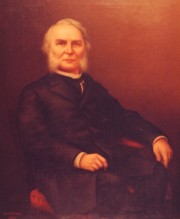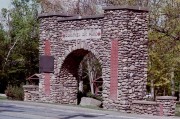reference to the civil war and images of civil war monuments and memorials

North New Portland hosts Morton’s Country Store, the Community Church, and Chase Memorial Hall. This village lies at the junction of routes 146 and 16, with Gilman Stream, and its Dam, flowing through it. See photos. The Carrabassett River, with its spectacular rocky bed, passes through East New Portland Village and under an arch bridge.

The Theater at Monmouth, specializes in Elizabethan productions. See photos. Highmoor Farm is part of the University of Maine’s agricultural experiment station network. This growing town is located on U.S. Route 202 between Augusta and Lewiston, making it a convenient location for commuters to each city.

With forty-one residents in 1800, Mercer exploded to a population of 1,432 (its peak) by 1840. Soon thereafter, Maine’s first starch factory was established. The library and the Grange are two surviving organizations formed in the late 19th century as the population continued to decline. See photos. The town lies on U.S. Route 2 just west of Norridgewock with frontage on North Pond at its southeast corner.
(1816-1892) a U.S. Representative, was born in North Gray on June 21, 1816. He attended the public schools and was tutored privately at home, later moving to Gray. A member of the Maine House of Representatives in 1845, 1847, and 1848, Mayall served in the Maine State Senate in 1847 and 1848. He declined the…

Lubec contains the easternmost point in the United States: West Quoddy Head, on which the famous lighthouse of the same name sits. See video and photos. A State Park is nearby. Lubec is the birthplace of Myron Avery, a key to the creation of the Appalachian Trail and a founder of the Maine Appalachian Trail Club. The sardine industry important in the late 19th & early 20th centuries.

This western-most town borders New Hampshire on the Salmon Falls River. A rapidly growing rural commuter community, Lebanon tripled its population between 1970 and 2010, adding 20% between 2000 and 2010. Settled in 1743, it was incorporated 1767. A meeting house was erected in 1753, two garrison houses in 1755, and a parsonage in 1759.

While growing slowly, this still small community retains its rural, farming and home town identity. Lagrange was named for the estate of the Marquis de La Fayette, the French friend of the American Revolution. See photos. A section of Maine Public Reserved Land is in the southwest corner of the township, managed for recreation and sustainable forestry.

in York County serves as the gateway to Maine from points south with its old and more modern bridges spanning the Piscataqua River. See video & photos. The federal government established the Navy Yard in 1806. The 74-gun ship Washington was the first vessel built there in 1815. The town’s long history is partially illustrated by the substantial list of historic sites.

Both Jay and Livermore Falls, have been paper mill towns on the River since the 19th century. See photos. Jay’s town line cuts through Livermore Falls village with little obvious effect. The VFW Post is just a few hundred feet north of Livermore Falls. Jay was the scene of an extended and bitter strike of workers against the International Paper Androscoggin mill in 18987-1988. The white granite for President Ulysses S. Grant’s tomb came from North Jay

William Sewall became a wildlife guide and companion to Theodore Roosevelt in the 1870′s. The town has frontage on almost half of Pleasant Lake. See photos. The nearby Walker Settlement hosts a golf course and residential development near the lake. Several large homes recall the heady days when potato was king in the County. One of those was that of Governor Carl E. Milliken. Island Falls has had industry in the form of lumber mills, grist mills and a starch factory.

1836 Birth in Boston 1854? Lithography workshop 1857 Free-lancing, Harper’s Weekly 1859 National Academy of Design 1862 Artist for Harper’s 1863+ Civil War paintings, Harper’s 1866 Prisoners from the Front 1867 Homer returns to New York 1872 Snap the Whip. 1875 1st view of Prouts Neck 1881 Northumberland, England 1882 Homer returns to New York…

Hancock Village lies south of the junction on a peninsular, with Taunton Bay on its northeast and Skillings River on the southwest. Further south are the villages of South Hancock and Hancock Point. See photos. A Wildlife Management Area near Egypt Bay is open to the public for primitive forms of recreation including hunting and trapping.

Named for the German city, and bombed by the British in 1814, Frankfort was once a shipbuilding community on the Penobscot River. Granite cutting and shipping was an important industry up to the early 20th century. Mount Waldo supplied the product and Marsh Bay, in the Penobscot River, provided the means of shipping it.

Fort Popham stands on Hunnewell Point in Phippsburg at the mouth of the Kennebec River. This semi-circular structure was begun in 1862 but never completed. It was then that the Union realized how vulnerable the area was to potential British incursions in support of the Confederacy during the Civil War. Concern was greatest for the…

The structure was begun in 1858, a year after Congress authorized funds, on Hog Island in Portland Harbor. By the end of the Civil War it was outdated with the invention of the rifle cannon that could destroy its granite structure. Fort Gorges is listed on the National Register of Historic Places. Currently owned by…

in York County, settled in the 1630s, on the east side of the Piscataqua River dividing Maine from New Hampshire, is a growing residential community serving Kittery and Portsmouth. See photos. Its population expanded by almost 12% in the 1990-2000 decade. Eliot was home to Maine’s first Quaker Meetinghouse built in 1776.

(1804-1897) was born in Portland on March 20, 1804. He was educated by his Quaker parents in the principles of temperance, industry, and thrift and attended the Friends Academy in New Bedford, Massachusetts. Instead of college, he entered his father’s tanning business and became a partner. He was successful in business and was called “one…

was born on April 4, 1802 in Hampden. A park in her honor was created in that town. She was the first child of three born to Joseph Dix and Mary Bigelow Dix. Her grandfather, Elijah Dix, owned land in Dixmont and Dixfield and lent those towns his name. While a young girl, her family…

Pleasant Mountain rises 2,006 feet among adjoining ridges and peaks. See photos. A hiking trail offers access and views of the surrounding countryside and of Moose Pond. Settled 1788 and incorporated 1807 in Oxford County, the town’s western line is the Saco River.

in Hancock County, settled 1810, incorporated 1837, is home to the historic Lucerne Inn and to the self-governing village corporation Lucerne-in-Maine, created in 1927. See photos and video. With two substantial lakes, Phillips and Green, the town is a growing recreational suburb of the Bangor-Brewer area.




















